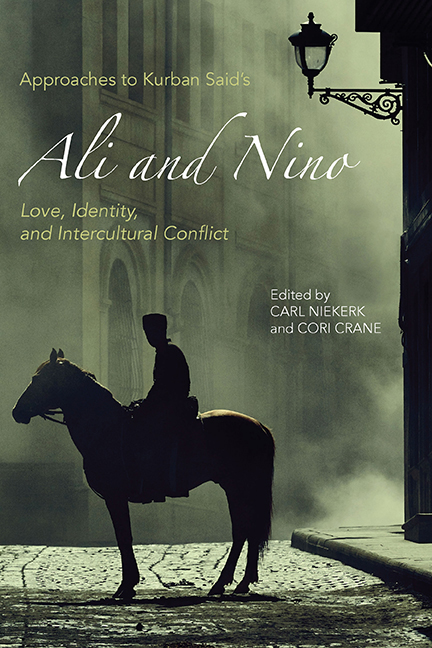Book contents
- Frontmatter
- Contents
- Acknowledgments
- Notes on Editions of and References to Ali and Nino
- Introduction: Ali and Nino as World Literature
- 1 Ali and Nino: The Novel as/of Cultural Translation
- 2 Crossing Borders, Crossing Disciplines: Ali and Nino in the Twenty-First Century
- 3 Glowing Rubies and Persian Daggers: The Role of Persian Poetry in Ali and Nino
- 4 Gendered Stereotypes and Cross-Cultural Moral Values through the Eyes of Kurban Said
- 5 Orientalist Itineraries: Cultural Hegemony, Gender, Race, and Religion in Ali and Nino
- 6 Gendered Conflicts in Muslim and Christian Cultures: Honor (and Shame) in Ali and Nino
- 7 Love and Politics: Retelling History in Ali and Nino and Artush and Zaur
- 8 “Herr Professor, Please: We'd Rather Stay in Asia”: Ali Khan Shirvanshir and the Spaces of Baku
- 9 The Female Body and the Seduction of Modernity in Ali and Nino
- 10 Seeing the Unseen: Symbolic Writing in Ali and Nino
- 11 Ali and Nino and Jewish Questions
- 12 Between Orientalism and Occidentalism: Culture, Identity, and the “Clash of Civilizations” in Ali and Nino
- Works Cited
- Notes on the Contributors
- Index
6 - Gendered Conflicts in Muslim and Christian Cultures: Honor (and Shame) in Ali and Nino
Published online by Cambridge University Press: 30 August 2017
- Frontmatter
- Contents
- Acknowledgments
- Notes on Editions of and References to Ali and Nino
- Introduction: Ali and Nino as World Literature
- 1 Ali and Nino: The Novel as/of Cultural Translation
- 2 Crossing Borders, Crossing Disciplines: Ali and Nino in the Twenty-First Century
- 3 Glowing Rubies and Persian Daggers: The Role of Persian Poetry in Ali and Nino
- 4 Gendered Stereotypes and Cross-Cultural Moral Values through the Eyes of Kurban Said
- 5 Orientalist Itineraries: Cultural Hegemony, Gender, Race, and Religion in Ali and Nino
- 6 Gendered Conflicts in Muslim and Christian Cultures: Honor (and Shame) in Ali and Nino
- 7 Love and Politics: Retelling History in Ali and Nino and Artush and Zaur
- 8 “Herr Professor, Please: We'd Rather Stay in Asia”: Ali Khan Shirvanshir and the Spaces of Baku
- 9 The Female Body and the Seduction of Modernity in Ali and Nino
- 10 Seeing the Unseen: Symbolic Writing in Ali and Nino
- 11 Ali and Nino and Jewish Questions
- 12 Between Orientalism and Occidentalism: Culture, Identity, and the “Clash of Civilizations” in Ali and Nino
- Works Cited
- Notes on the Contributors
- Index
Summary
RELIGIOUS, GENDERED, AND CULTURAL CONFLICTS abound in Ali and Nino and can be understood through the lens of honor, a foundational phenomenon in nearly every culture. Honor consistently plays a central role in defining the conflict between Ali, an Azerbaijani Muslim youth, and his Christian Georgian future wife, Nino. Their Romeo-and- Juliet love story explores the tensions inherent in these pairings. Honor is part of the conflict not just between two families, but also between complex, ever-changing pairings: male and female, public and private, Muslim and Christian, East and West. The conflicts about honor and shame in Ali and Nino offer a peek at the fluid boundaries between religion, culture, and politics.
Between the Oriental and European norms concerning female and male honor, the story of the two lovers unfolds across European and Middle-Eastern stages, where Muslim Ali must defend his own honor in his Middle-Eastern culture, as well as Christian Nino's honor in both Middle Eastern and Western settings. The honor structures that Ali and Nino encounter are flexible and—despite the apparent differences between East and West, masculine and feminine—do in fact complement one another or overlap at times. Ali and Nino plays with honor systems that at first sight appear contradictory, mostly by focusing on the Azerbaijani (Muslim, Oriental) honor system, but with instances where Western honor (Christian, Occidental) is thematized as well, demonstrating that honor codes in Azerbaijan mirror the country's political and geographical situation. Parallel to the political situation, the individual female body possesses a certain geography; it can be placed within a larger social constellation and be “mapped” within a certain geography in the novel and can be placed within a larger constellation. We see this in both Nino's relations with other men and the tensions between the country Azerbaijan (easily thought of as feminine) and other, larger forces that claim the country (and its riches) as their own.
Eastern Communitarianism vs. Western Political Liberalism
Ali and Nino offers Western readers a glimpse of Eastern culture. Kurban Said wrote a text positioned between cultures, and we must keep in mind that he is interested in how social and cultural systems interact with each other. Ali's culture and honor codes are perceived within a communitarian system, in which a communitarian identity dominates all others.
- Type
- Chapter
- Information
- Approaches to Kurban Said's Ali and NinoLove, Identity, and Intercultural Conflict, pp. 114 - 134Publisher: Boydell & BrewerPrint publication year: 2017

